In a world where your utility bills seem to be on an ambitious quest to empty your wallet, it's time to fight back with some clever climate control hacks. You've probably heard some of them before, like embracing smart thermostats or maximizing insulation efficiency, but implementing these tips can greatly reduce your energy consumption and costs.
With just a few adjustments, such as sealing all air leaks or utilizing energy-efficient lighting, you can enjoy a more comfortable home and a happier bank account. Let's explore how these 10 simple changes can make a big difference in your life and leave your utility bills wondering what hit them.
Key Takeaways
- Installing smart thermostats can reduce heating and cooling costs by up to 10%.
- Sealing air leaks and maximizing insulation can save up to 30% on energy bills.
- Solar panels offer significant savings, with a return on investment in 5-7 years.
- Lowering water heater temperature by 10°F can reduce energy costs by 3-5%.
Embrace Smart Thermostats
Embracing smart thermostats can greatly reduce your heating and cooling costs, saving you up to 10% by fine-tuning your home's temperature with ease and efficiency. These clever devices allow you to control the climate from anywhere using your phone.
Imagine adjusting your home to the perfect temperature while you're on your way back from work. Smart thermostats learn your schedule and preferences, optimizing energy usage without sacrificing comfort. Plus, they provide energy reports, helping you understand your habits and how to improve them.
Maximize Insulation Efficiency

By boosting your home's insulation, you can slash your energy bills by up to 20% a year. Insulation isn't just about keeping warm; it's a cornerstone of energy efficiency. It helps maintain a consistent temperature, meaning you won't have to overwork your heating system.
Here's how to make the most of it:
- Insulate Walls and Attics: Up to 30% of energy savings come from well-insulated walls and attics.
- Wrap Pipes: Prevent heat loss and improve efficiency by insulating your pipes.
- Maintain Consistent Temperatures: Good insulation reduces the need for excessive heating, keeping your home comfortable year-round.
Embrace these simple steps, and you'll not only cut costs but also contribute to a more energy-efficient, comfortable home.
Seal All Air Leaks

Sealing air leaks in your home can effortlessly save you up to 10% on your annual utility bills, preventing unnecessary heat loss and keeping your space snug. Air leaks, often lurking in basements, attics, windows, and doors, ramp up your energy consumption without you even noticing.
By embracing sealing, you're not just cutting down on heating costs; you're ensuring a consistent indoor temperature, easing the strain on your heating and cooling systems. Grab some caulk or weatherstripping and tackle those gaps and cracks. It's a simple step towards improving energy efficiency.
Plus, by keeping cold drafts at bay, you'll enjoy a cozier living environment, slashing energy waste and fostering a warm, inviting atmosphere in your home.
Program Your HVAC
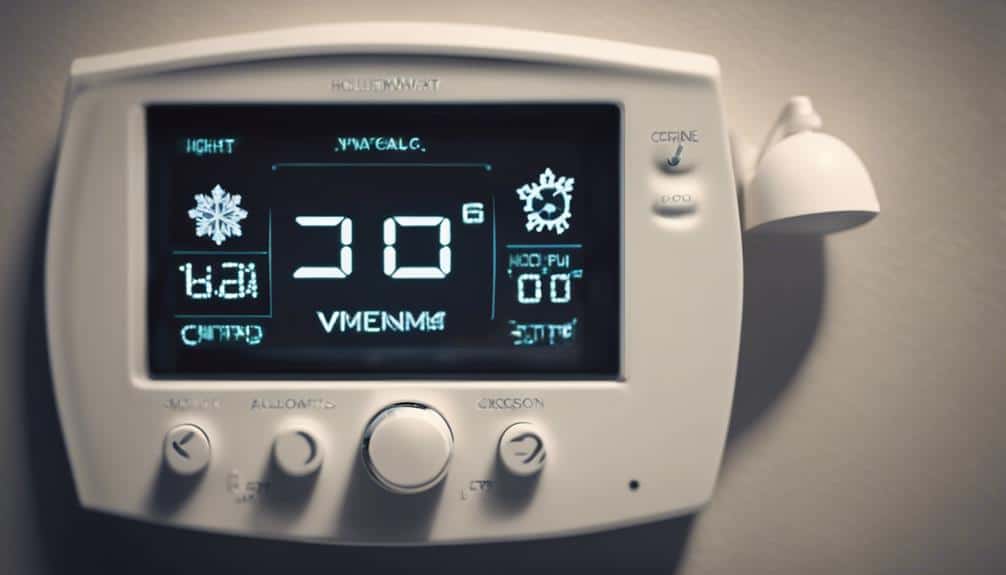
Taking control of your HVAC system through programming can effortlessly shave up to 10% off your annual heating and cooling costs. By smartly managing your home's climate, you not only reduce energy consumption but also save money in the process.
Here's how to make it work for you:
- Set Different Temperatures: Adjust your thermostat for various times of the day. Lower temperatures at night and when you're not home can notably cut down on energy use.
- Go Smart: Utilize smart thermostats for the ultimate convenience in remote control and energy-efficient scheduling.
- Away Adjustments: Make sure to tweak settings when your house is empty. Preventing unnecessary heating or cooling goes a long way in saving energy.
Embracing these simple steps can lead to noticeable reductions in your utility bills, bringing both warmth and savings into your home.
Utilize Energy-Efficient Lighting
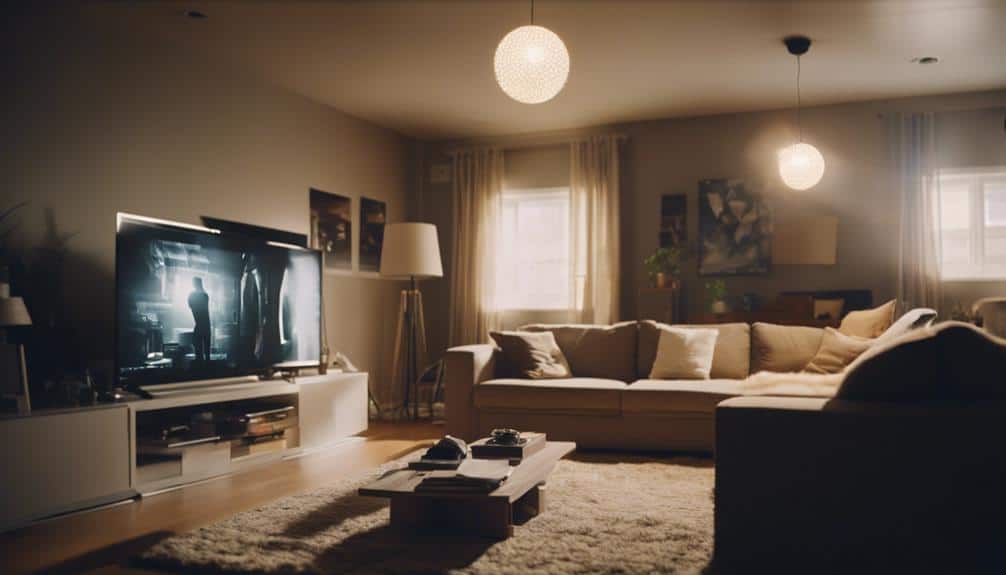
Switching to LED bulbs is a simple yet effective way to cut down your energy use and save money on your electric bill.
By incorporating smart lighting controls and making the most of natural light, you'll enhance the efficiency of your home even further.
These changes not only benefit your wallet but also contribute positively to our planet's health.
LED Bulbs Benefits
One of the smartest moves you can make to cut down on energy bills is upgrading to LED bulbs, which aren't only kinder to your wallet but also to the planet. When you switch to these energy-efficient lights, you're setting yourself up for significant cost savings. Here's why:
- Energy Efficiency: LED bulbs use up to 75% less energy than traditional lighting, slashing your electricity consumption.
- Longevity: They last up to 25 times longer than incandescent bulbs, meaning fewer replacements and more money saved.
- Reduced Cooling Costs: Producing less heat, LED bulbs help keep indoor spaces cooler, further lowering your utility bills.
Embracing LED bulbs is a bright idea that benefits your home, your budget, and the environment.
Smart Lighting Controls
After exploring the benefits of LED bulbs, let's consider how smart lighting controls can further enhance your home's energy efficiency.
These savvy devices aren't just about convenience; they're a game-changer for managing your energy use more effectively. With smart lighting controls, you can easily adjust settings or schedule your LED bulbs to turn on and off, ensuring you're only using light when needed.
Plus, opting for motion sensor lights in common areas means you'll never forget to switch off a light again. This smart setup not only trims down your utility bills but also extends the lifespan of your energy-efficient LED bulbs.
Natural Light Maximization
Harnessing the power of natural sunlight in your home not only reduces your reliance on artificial lighting but also embraces energy efficiency at its finest. By inviting more natural light into your spaces, you're stepping into a world where energy-efficient lighting shines.
Let's immerse into how you can illuminate your home more naturally:
- Maximize natural light by opening windows and trimming any vegetation that blocks sunlight, minimizing the need for artificial lighting.
- Switch to energy-efficient lighting options like LED and smart bulbs, which complement natural light and slash electricity costs.
- Incorporate smart lighting controls to adjust artificial lighting levels automatically, ensuring you use just enough light, based on the natural light available.
Embrace these strategies to enhance your home's luminosity and energy efficiency, creating a warm, inviting atmosphere that's both cost-effective and eco-friendly.
Install Solar Panels
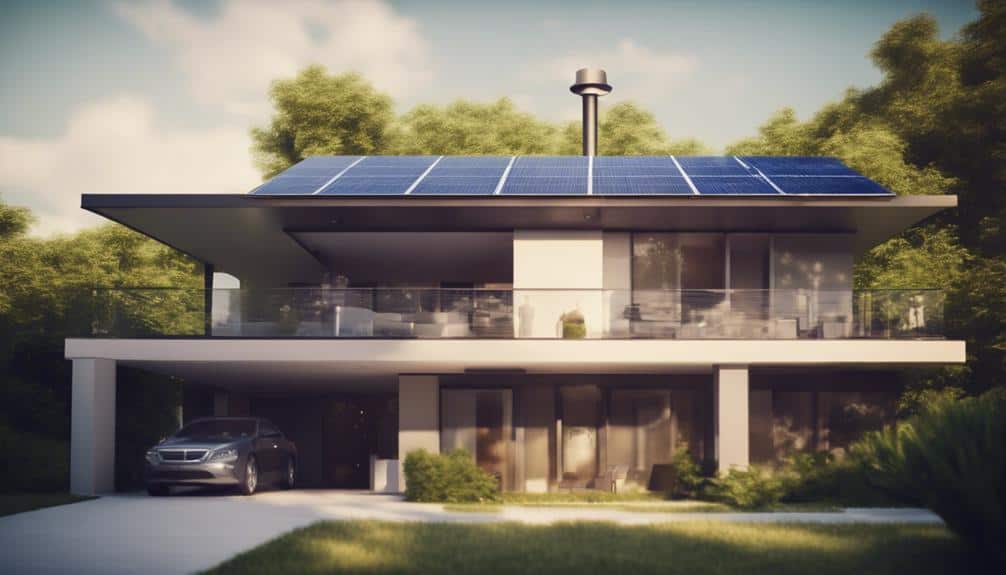
Switching to solar panels isn't just good for the planet; it's smart for your wallet too.
You'll see the savings pile up on your energy bills, and your home's value could get a nice boost.
Let's explore how these benefits come to life, what you can save, and what the installation looks like.
Solar Panel Benefits
Installing solar panels on your home can slash your electricity bills by up to 70%, making it a smart financial move. Beyond just savings, here's how a solar upgrade can benefit you:
- Increase Home Value: Homes with solar panels can see up to a 4% increase in property value. It's not just about savings; it's an investment in your home's worth.
- Longevity: Solar panels have a hefty lifespan of 25-30 years, ensuring you enjoy benefits for decades.
- Sustainability: By opting for solar panels, you're choosing a renewable energy source, reducing your carbon footprint and contributing to a healthier planet.
Consider adding a solar hot water heater to maximize your solar panels' efficiency. It's a step towards a more sustainable and financially savvy lifestyle.
Cost and Savings Analysis
Diving into the financial aspects, you'll find that solar panels not only cut your electricity bills by up to 70% but also offer significant savings and incentives. Initially, the cost might seem steep, but federal tax credits and state incentives are there to lighten the load. In fact, the savings kick in so quickly that you could see a return on your investment in just 5-7 years.
Plus, imagine adding an average of $15,000 to your home's value simply by making it more energy-efficient. And let's not forget the environmental bonus – reducing carbon emissions by 3-4 tons yearly. With solar panels, the savings extend beyond just your electricity bills, impacting your wallet positively and contributing to a healthier planet.
Installation Process Overview
After exploring the financial benefits of solar panels, let's look at how you can get them up and running on your rooftop. The installation process is straightforward but requires attention to detail to guarantee everything works perfectly. Here's a brief overview:
- Mounting Setup: Professionals secure mounting brackets and rails to your rooftop, creating a sturdy base for the solar panels.
- Panel Placement: Next, the solar panels are carefully attached to the mounts. They're connected in series to form an array, making sure each panel captures sunlight efficiently.
- Wiring and Conversion: Finally, the array is connected to an inverter, transforming DC power into AC power for your home use.
Installation experts guarantee your panels are perfectly oriented and tilted for maximum sunlight exposure, adhering to local building codes for your safety and the system's efficiency.
Leverage Ceiling Fans
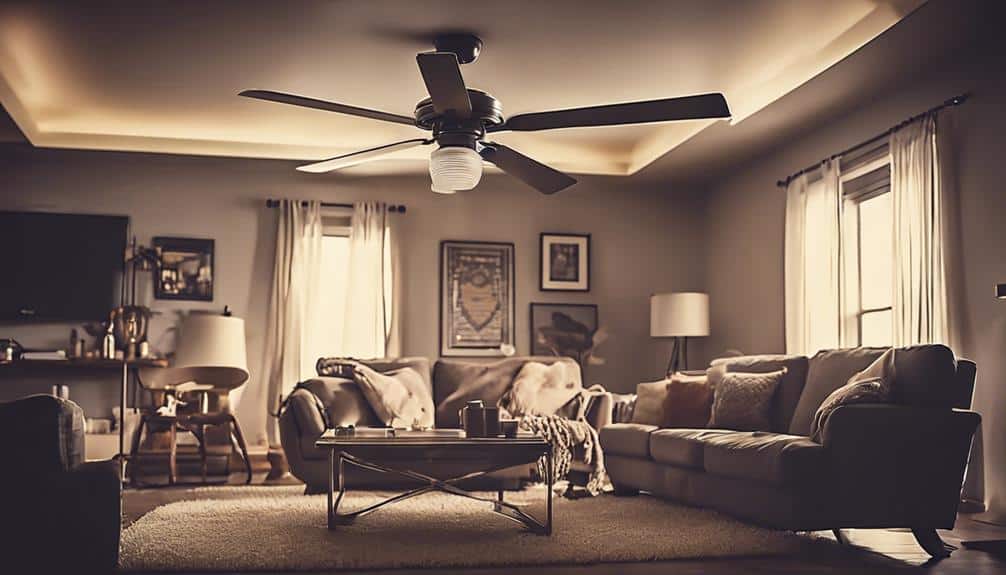
By changing the direction of your ceiling fans to clockwise in winter, you'll push warm air down and enhance the circulation throughout your room. This simple adjustment means you're not just stirring up cold air; instead, you're redistributing the warmth that rises to the ceiling back into your living space.
It's a straightforward yet effective way to boost energy efficiency and comfort without cranking up the thermostat. By leveraging the power of ceiling fans, you can greatly reduce heating costs. They're the unsung heroes of energy conservation, subtly easing the workload on your heating system by ensuring even distribution of heat.
Embracing this method not only improves your home's warmth but also contributes to a noticeable decrease in energy consumption, making your winter days cozier and your utility bills lighter.
Reduce Water Heater Temperature

Following the theme of optimizing your home's energy efficiency, another impactful step is reducing your water heater temperature. This simple adjustment can lead to significant savings on your energy costs without compromising your comfort.
Here's how it benefits you:
- Lower Energy Bills: Dropping your water heater temperature by 10°F could slash your energy bill by 3-5%. That adds up over time, giving you more room in your budget for what truly matters.
- Enhanced Safety: A cooler temperature setting, ideally around 120°F, minimizes the risk of scalding accidents, keeping your household safer.
- Simple Efficiency: It's an easy tweak that makes your water heater work less hard, prolonging its lifespan while conserving energy.
Opt for Energy Star Appliances
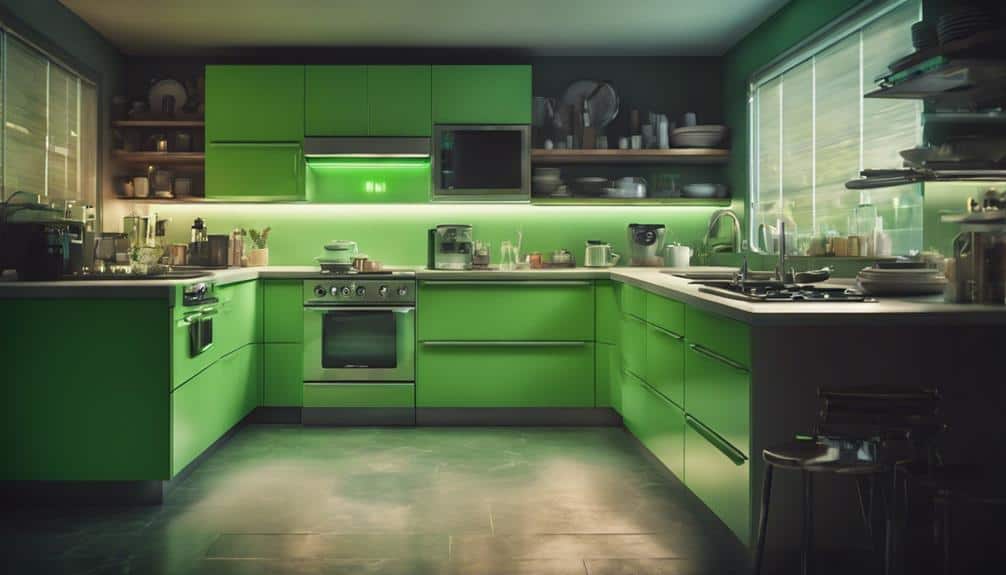
Switching to Energy Star appliances can greatly reduce your energy use, offering both financial savings and environmental benefits. These aren't just any gadgets; ENERGY STAR certified appliances adhere to the strict energy efficiency guidelines set by the Environmental Protection Agency and Department of Energy.
Imagine using 10-50% less energy with your refrigerators, dishwashers, and washing machines without sacrificing performance. That's not just good for your wallet; it's a significant step towards reducing your carbon footprint. By choosing these eco-friendly warriors, you're contributing to a more sustainable planet.
Plus, the long-term savings on your utility bills will make this switch a smart financial move. Opting for ENERGY STAR certified appliances is a win-win, promoting energy conservation while keeping more money in your pocket.
Encourage Natural Ventilation

Encouraging natural ventilation in your home can significantly improve air quality and reduce reliance on air conditioning. By letting the breeze in, you're not just freshening up your space; you're also giving your AC a much-needed break.
Here's how to make the most of the air around you:
- Open windows strategically to create a cross-breeze, especially on opposite sides of the room. This enhances airflow and helps cool your home more efficiently.
- Install window vents or trickle vents to allow for continuous air circulation without compromising your home's security.
- Harness the stack effect by opening windows at different levels, encouraging cooler air to enter at lower points and warm air to exit up high.
Frequently Asked Questions
What Is the Simple Trick to Cut the Electric Bill?
You're looking for a simple trick to cut your electric bill? Try smart lighting, water conservation, and appliance timing. These small changes can lead to big savings, making your home more energy-efficient and wallet-friendly.
What Runs Your Electric Bill up the Most?
Your electric bill spikes mostly due to inefficient appliances, poor lighting choices, and water heating. Upgrading to efficient models, opting for LED lights, and tweaking your water heating settings can greatly reduce your costs.
How Can I Reduce My Thermostat Bill?
To cut your thermostat bill, consider installing smart curtains, improving window insulation, and optimizing thermostat placement. These steps help maintain your home's temperature efficiently, so you're comfortable while saving money.
How Can I Reduce My Kwh Usage?
To reduce your Kwh usage, you can upgrade to energy-efficient appliances, invest in smart window treatments, and switch to advanced lighting. These steps not only cut costs but also enhance your home's comfort and efficiency.
Conclusion
By embracing these climate control hacks, you're not just slashing your utility bills; you're also stepping towards a greener, more sustainable lifestyle. Smart thermostats, efficient insulation, and energy-saving appliances are your allies in this journey.
Remember, every small change adds up. So, start today, make those adjustments, and enjoy the comfort of your home without the financial strain.
Let's not only save money together but also protect our beautiful planet for generations to come.

